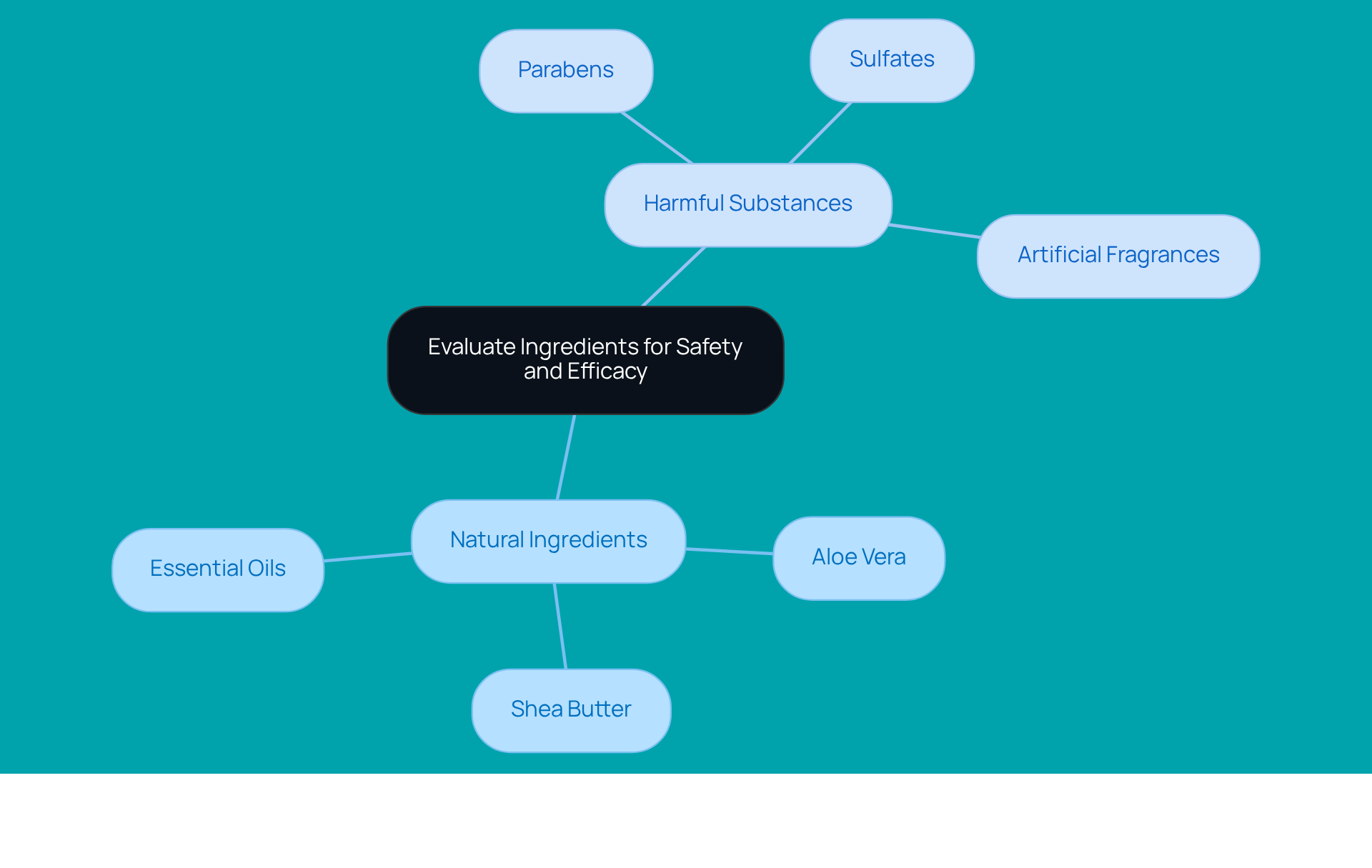Overview
Choosing safe bath and body products is essential for your well-being, and we understand how overwhelming this process can be. The article outlines four best practices to help you navigate this journey with confidence.
-
Evaluating ingredients is crucial. Imagine if you could easily identify what goes into the products you use daily. This practice not only promotes transparency but also aligns your choices with your health goals.
-
Understanding marketing claims is important. Have you ever felt confused by the buzzwords on packaging? By demystifying these claims, you empower yourself to make informed decisions.
-
Implementing patch tests is another vital step. You might be wondering how to identify potential allergies—patch testing can be an effective way to safeguard your skin.
-
Each of these practices is supported by evidence and examples, highlighting the benefits of natural ingredients and the significance of ingredient transparency. Together, they promote informed consumer choices that lead to better skin health.
As you embark on this wellness journey, remember that you're not alone. By following these best practices, you take meaningful steps toward nurturing your skin and overall health.
Introduction
Choosing bath and body products can often feel overwhelming, can’t it? With a myriad of options available and complex ingredient lists, it’s easy to feel lost. But understanding how to select safe and effective products is not just about preference; it’s a crucial aspect of your personal wellness journey. As we become more aware of the potential risks associated with harmful chemicals, the challenge lies in deciphering marketing claims and making informed decisions that truly align with our health goals.
Imagine if you could confidently choose products that nurture your skin without compromising safety. What steps can we take together to ensure that the products we select genuinely support our wellness? Let's explore this important topic and empower ourselves to make choices that reflect our values and health aspirations.
Evaluate Ingredients for Safety and Efficacy
When it comes to selecting bath and body products, it's essential to pay close attention to the ingredients list. Have you ever wondered what’s really in the products you use? Look for natural components that are known for their safety and effectiveness, such as:
- Aloe vera
- Shea butter
- Essential oils
These ingredients not only nurture your skin but also promote your overall wellness.
On the other hand, it’s wise to steer clear of products containing harmful substances like:
- Parabens
- Sulfates
- Artificial fragrances
These can provoke irritation or lead to long-term health concerns. Imagine using bath and body products that not only feel good but are also gentle on your body! Research studies have shown that natural ingredients not only enhance skin health but also reduce the risk of allergic reactions. For instance, a study published in the Journal of Dermatological Science highlighted the advantages of using products with natural oils over synthetic alternatives.
Always prioritize products that are transparent about their ingredient sourcing and formulation methods. By making informed choices, you’re taking a significant step toward a healthier you. Together, we can embrace a wellness journey that celebrates the beauty of nature.

Align Product Choices with Health Goals
When it comes to selecting bath and body products, it's crucial to consider your unique wellness objectives. Imagine if you could choose products that truly resonate with your skin's needs. For those seeking to moisturize dehydrated skin, look for items enriched with hyaluronic acid. This remarkable ingredient has been shown to boost hydration by up to 134% immediately after application and maintain a 55% increase over time.
If anti-aging is your focus, you might be wondering which formulations to choose. Seek out products containing antioxidants like vitamin C or retinol, known for their skin-rejuvenating properties. A heartening case study within a wellness community revealed that individuals who aligned their skincare choices with personal health objectives experienced notable improvements in both skin condition and overall well-being. This tailored approach not only enhances the effectiveness of the products but also fosters a more satisfying skincare experience.
However, let’s be cautious of common pitfalls. Choosing items based solely on marketing claims can lead to disappointment. Instead, research indicates that personalized selections can significantly elevate satisfaction and skin health outcomes. Together, let's reinforce the importance of making informed choices that truly support your wellness journey.

Decipher Marketing Claims and Product Labels
Marketing claims like 'natural,' 'organic,' and 'hypoallergenic' can sometimes feel confusing, can't they? These terms are often used to attract consumers without substantial backing, leaving many of us uncertain about what they truly mean. To help you make informed choices, it’s essential to familiarize yourself with the regulatory definitions of these terms. For example, the term 'organic' should be backed by certification from recognized bodies. Without such certification, claims based on 'natural' and 'organic' can be misleading.
As you examine labels, keep an eye out for any disclaimers or fine print that might suggest limitations of the claims presented. Imagine discovering that a product labeled as 'natural' actually contains synthetic components! A study by Consumer Reports found just that, highlighting the necessity of caution in our choices. In fact, did you know that 62% of younger buyers, ages 18 to 29, are willing to pay a premium for organic items? This statistic underscores the importance of understanding these marketing claims.
By learning how to analyze these assertions, you can steer clear of products that don’t meet your expectations. It’s also important to note that the term 'hypoallergenic' varies by brand, and there is no official definition, which can lead to misconceptions. Therefore, being informed about these terms is crucial for making safe and effective choices. Together, let’s navigate this landscape and empower ourselves to make better decisions for our wellness journey.

Implement a Patch Test for New Products
Before you dive into using a new bath and body product, it’s important to take a moment for a simple yet effective practice: the patch test. Imagine applying a small amount of the product to a discreet area of your body, like the inside of your wrist or behind your ear. By doing this, you can monitor for any reactions over a 24-hour period. This straightforward test can be a game changer, helping you identify potential allergies or sensitivities and avoiding any discomfort or adverse effects.
Dermatological guidelines strongly recommend patch testing for all new items, especially those containing active ingredients. You might be wondering just how effective this practice is. According to a study, the positive rate of patch testing in patients diagnosed with contact dermatitis was an impressive 86%. This underscores the effectiveness of taking this precaution.
Common allergens identified in patch testing include:
- Nickel sulfate, which has a positivity rate of 31.0%
- Gold sodium thiosulfate at 19.0%
By taking this small step, you can confidently explore new products while prioritizing your dermal health. Regular patch testing is not just a recommendation; it’s crucial for identifying allergens and aligns with best practices for maintaining sensitive skin. This ensures that your skincare routine remains safe and effective.
Together, let’s make informed choices for our skin. By incorporating patch testing into your routine, you’re not just protecting yourself; you’re embracing a proactive approach to your wellness journey.

Conclusion
Choosing the right bath and body products is essential for nurturing your skin and enhancing your overall wellness. Imagine if you could select products that not only feel wonderful but also support your health. By prioritizing safety and efficacy, you can create a skincare routine that truly resonates with your personal health goals. Understanding the importance of ingredient transparency can lead to a more satisfying and beneficial skincare experience.
Throughout this journey, we've highlighted key practices that empower you—such as:
- Evaluating ingredient safety
- Aligning products with your specific health objectives
- Deciphering marketing claims
- Implementing patch tests for new items
Each step is a chance to make informed decisions, steering clear of harmful substances while embracing natural alternatives that nurture your skin. Recognizing the significance of these practices allows you to enhance your skincare routine and foster a deeper connection with your health and beauty choices.
Ultimately, your journey to healthier skin begins with knowledge and proactive decision-making. By embracing the best practices we've outlined, you can confidently navigate the often confusing landscape of bath and body products. This commitment to informed choices not only protects your skin health but also promotes a holistic approach to personal wellness. Together, let’s make these conscious decisions today to pave the way for a more vibrant and healthy tomorrow.
Frequently Asked Questions
Why is it important to evaluate ingredients in bath and body products?
Evaluating ingredients is essential to ensure safety and efficacy, as it helps consumers avoid harmful substances and choose products that nurture the skin and promote overall wellness.
What are some safe and effective natural ingredients to look for in bath and body products?
Safe and effective natural ingredients include aloe vera, shea butter, and essential oils, which nurture the skin and enhance overall wellness.
What harmful substances should be avoided in bath and body products?
Harmful substances to avoid include parabens, sulfates, and artificial fragrances, as they can cause irritation and long-term health concerns.
What benefits do natural ingredients have over synthetic alternatives?
Natural ingredients can enhance skin health and reduce the risk of allergic reactions, as supported by research studies, including one published in the Journal of Dermatological Science.
How can consumers make informed choices about bath and body products?
Consumers should prioritize products that are transparent about their ingredient sourcing and formulation methods to ensure they are making healthy choices.
What is the overall message regarding the use of natural ingredients in bath and body products?
The overall message is to embrace a wellness journey that celebrates the beauty of nature by choosing bath and body products with natural ingredients for better health and skin care.




